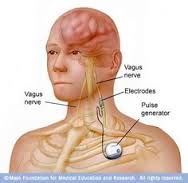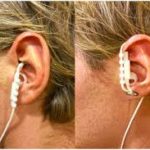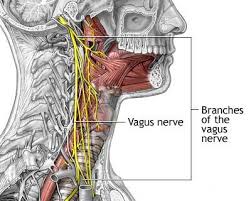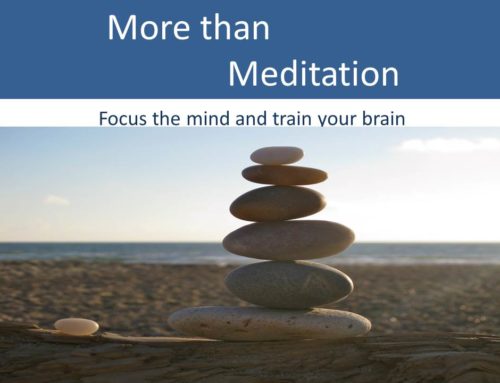The vagus nerve is one of the most important nerves in the body and its central role in all functions of the body is being revealed with an explosion of research.
It is the 10th cranial nerve and arises above the midbrain. It comes out through the base of the skull and passes down the side of the neck into the body.
It influences many things including facial expression, brain hormones,regulation of the nervous system to the heart. It influences the gut and all the other organs in the abdomen eg.the liver, kidney and spleen. It also influences the network of blood vessels, fat and connective tissue that covers the GI tract, called the mesentary.
The vagus nerve is essential in understanding heart rate variability (The window into the nervous system). The vagus nerve innervates the diaphragm and influences breathing.
It conveys information from the brain to the body but also transmits information from the body organs back into the brain.
The vagus nerve is part of the parasympathetic nervous system, the second arm of the autonomic nervous system. The other arm is the sympathetic nervous system.
The sympathetic nervous system is better known as the fight or flight response. It is the system that alerts us to stressful situations and activates our body’s stress response mechanisms. This system primes the body to deal with emergencies. The vast majority of people are stressed and live in environments of stress. In this state, the sympathetic nervous system is constantly switched on. This results in increased levels of the hormone, cortisol. The consequences of this include high blood pressure, increased risk of infection, weight gain, and heart rhythm irregularities. It also increases the sensitivity to pain, aggravates the symptoms of fibromyalgia and insomnia and in those genetically predisposed, can increase the incidence of auto immune disease.
The parasympathetic nervous system has the primary role of turning the sympathetic nervous system off and self-regulating physiological functions. It is known as the relaxation response or the restful alertness response.
 The parasympathetic nervous system via the vagus nerve pathways can be activated by meditation. The vagus nerve when stimulated also induces the relaxation response. The tone of your voice and the facial muscles are influenced by vagus nerve stimulation and you can see and feel the relaxation response.
The parasympathetic nervous system via the vagus nerve pathways can be activated by meditation. The vagus nerve when stimulated also induces the relaxation response. The tone of your voice and the facial muscles are influenced by vagus nerve stimulation and you can see and feel the relaxation response.
The response of vagal nerve stimulation can be measured in a number of ways including an increase in lung capacity and an increase in heart rate variability.
Parasympathetic nerve system self-regulation and the return of the body to a state of homoeostasis (balance) contributes to well-being and improved health. It is an anti-inflammatory state. On the other hand, constant activation of the sympathetic nervous system promotes inflammation.
The vagus nerve influences the microbiome. Gut health and knowledge about the microbiome ( the bacteria that live and function within the gut,) has entered into mainstream awareness and
understanding. The gut bacteria not only produce beneficial chemicals and hormones that the body uses but also contain extraordinary amounts of genetic material and this interacts with the human genome in ways that are only now being researched. The vagus nerve is central to these gut processes.
Vagal nerve stimulation ( VNS)
 Vagal nerve stimulation returns the body to a state of homoeostasis and this, in turn, has been shown to have very significant health benefits.
Vagal nerve stimulation returns the body to a state of homoeostasis and this, in turn, has been shown to have very significant health benefits.
Vagal nerve stimulation significantly influences brain hormones particularly those involved in depression and is becoming a very useful treatment strategy. These brain hormones are potent immune modulators.
Vagal activity can be altered by behavioral, pharmacological, and surgical interventions.
Some effects of vagal nerve stimulation include:
Reduces somatic pain sensitivity as well as having strong analgesic effects. There is preliminary evidence to suggest it may be of benefit in fibromyalgia and other central pain states. It reduces the frequency and severity of migraine.
There is a decreased risk of heart disease and it is used in the treatment of heart failure, atrial fibrillation, and ventricular arrhythmias.
VND Improves respiratory function.
It is used to treat refractory epilepsy and depression.
VNS reduces rheumatoid arthritis severity. The vagus nerve carries immune-related signals, which makes it a good target for bioelectronic treatment for autoimmune conditions such as rheumatoid arthritis, Crohn’s disease and lupus.
 Effective in cancer management and prevention.
Effective in cancer management and prevention.
Up until recently, stimulation has required implantable electrodes however transcutaneous methods of stimulation are becoming available.
10 ways to stimulate the vagus nerve simply without electrical devices:
- Slow deep breathing. An example would be to breathe in slowly for a count of 4 and out for a count 6 to 8. The average normal breathing rate is between 12 and 14 per minute. This slow breathing reduces it to 6 to 7 per minute.
- Any exposure to cold. eg rinse your hands and face in cold water.
- Singing, chanting, gargling and humming
- Laughter
- Restorative yoga postures such as the cat cow posture and downward dog
- Meditation.
- Evoking the emotions of love, compassion and empathy.
- Exercise
- Massage/acupuncture, acupressure
- Intermittent fasting






